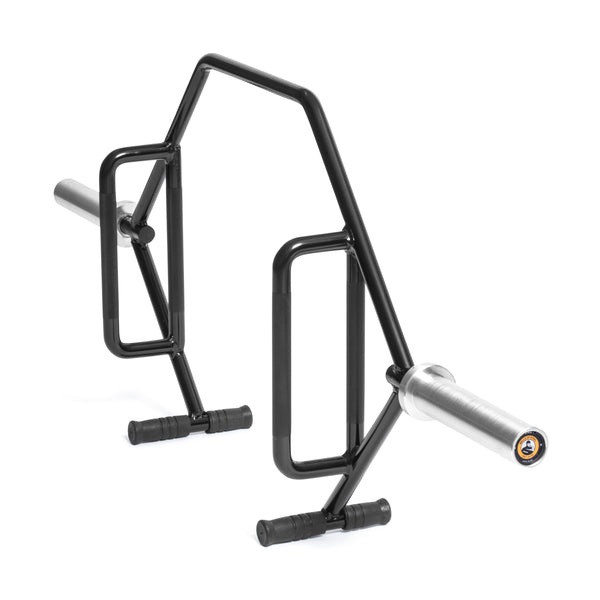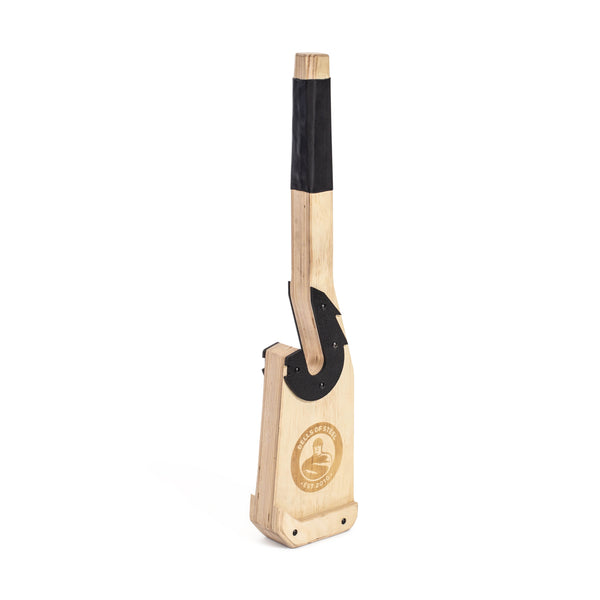One of my favourite things about using an open trap bar is the extra versatility it provides with exercises. Sure, having a built-in deadlift jack and rotating sleeves found on some open trap bars (such as the Bells of Steel Open Trap Bar) make the lifting experience much more enjoyable overall. Still, if I could only pick one feature afforded by an open trap bar, I’d take its versatility any day of the week.
Getting the most versatility out of your equipment not only provides better value for your investment but can also help you get more done within a smaller space while keeping your training fresh and enjoyable with the added variety.
In this article, I’ll show you three open trap bar exercises that I use for myself, the patients I treat in the clinic, and the clients I train in the gym. While all three of these exercises are unique in their own way, they all share a common theme of challenging (thus, improving) lower body strength, endurance, and balance. Each open trap bar exercise is outstanding for improving movement control and strength of the hip muscles (something that will go a very long way when it comes to reducing injury, trust me).
Additionally, they will each tax your quads and hamstrings in the process, which will not only improve stability and control of your knees but also improve the strength and endurance of your lower body.
This means reduced injury potential of the lower body and improved strength and endurance of these muscles. Not bad for three open trap bar exercises, eh? While nearly every lifter or athlete can benefit from these exercises, they are especially beneficial for those who have noticeable strength or movement control differences in one side of their lower body to the other. So, if you are performing sports or activities that require you to have strong hips and legs along with good movement control of your lower body from one side to the other, you’ll want to give these exercises a try! These lower body open trap bar exercises are:
Can these exercises be performed with other equipment, such as dumbbells or a barbell? Of course. But you can’t do them with a traditional trap bar (i.e., one that is closed all the way around). And while you can use dumbbells, heavy kettlebells, etc., for these exercises, some unique benefits come along for the ride when using an open trap bar, which I’ll explain with each exercise.
Also, note that for image clarity, I’m performing each of these exercises with only the bar itself (so the plates don’t obscure your view of the movements; add whatever weight to the bar you may feel you need!)
The single-leg Romanian deadlift (RDL) is a staple exercise for anyone who wants to build a bulletproof backside while simultaneously strengthening their hip stabilizers. And to kick it up a notch, we’re going to add a vertical row to the movement while holding the RDL position.
Not only will this additional movement light up your mid and upper back muscles, but it will also force you to produce much more control and stability through your hip and stance leg, making it a brutally challenging (and effective) exercise for those who need some effective lower body strengthening.
Many individuals struggle to do this movement with independent weights, such as kettlebells or dumbbells. The open trap bar can improve balance and control for this exercise since the weight is connected from side to side, acting like a balancing pole for a tightrope walker.
The starting position for the RDL to row exercise The RDL position. Performing the row while holding the RDL position.
- Perform a single-leg Romanian deadlift.
- Once you’ve gone as far as you can, hold the position and maintain balance.
- Pull the open trap bar up towards your chest as high as you can
- Lower the bar back down until your arms are straight.
- Return to the full standing position and repeat for desired repetitions.
Want to kick it up a notch? When you return to the full, upright position, don’t let your foot touch the floor. If you can perform all of your repetitions while keeping 100% of your weight on your stance foot at all times, your hip muscles and leg will be feeling it. I use this exercise for clinical rehab with many of my patients; it’s like a Swiss army knife for all that it offers for lower extremity rehabilitation or injury prevention.
You will isometrically load your quads while strengthening your soleus muscle (a muscle that sits just underneath the calf muscles) and improve general knee and ankle strength and stability in the process. And if you’re wondering what an “isometric” is, it simply refers to making a muscle hold a contraction without the muscle producing any movement in the process.
Unless you’ve got a pair of heavy dumbbells or kettlebells, you might not have enough load in your hands to make this exercise as challenging as you might need it to be. Pop some weight onto each side of the open trap bar and this will no longer be an issue.
The starting position for the static lunge with ankle pump. This position will be slightly shorter than a lunge, which will allow you to lift your heel higher off the ground. The ankle pump. From here, slowly lower your heel back to the floor and repeat the process. Note here how I am leaning forward slightly to load up the front leg throughout the duration of the exercise.
- Assume a slightly shortened lunge position (the lower you are in your lunge stance, the more challenging this exercise will be).
- Slowly lift the heel of your front foot up off the floor as high as possible, then slowly lower it back to the floor. Repeat for as many repetitions as you can handle.
Want to kick it up a notch? Use a tandem stance so that your back foot is directly behind your front foot (as if walking a tight rope). This narrow base of support will force you to work extra hard to maintain your balance and force you to go extra slow, making the movement much more challenging overall.
And if you really want to kick it up a notch, place the ball of your front foot on a sturdy ledge, such as a step, so that you can drop your heel down even further, taking your ankle and calf muscles through a more extensive range of motion. If there were only one type of lunge I could do for the rest of my days, this just might be the one. Not only does this lunge work both legs at the same time, but it also hammers the quadriceps and glutes equally since you’re lunging backwards (a quad-dominant motion) and forwards (a dominant glute motion) in equal amounts.
Dropping into the backwards lunge can be tricky if you have poor balance. The trap bar helps with balance since the weight is connected from side to side, acting like a balancing pole. As well, many lifters or active individuals require a moderately heavy weight for lunges, often heavier than what they may have with dumbbells or kettlebells.
The forward to backward lunge. Note how in this photo the left foot stays in place throughout the duration of the exercise. Try to keep your lunging leg off the ground when moving from one direction to the other (but you can tap your toe, like in the picture, at the halfway point if you need a bit of extra balance).
- Lunge forwards as you normally would.
- When coming out of this lunge, push yourself backwards with enough force to propel yourself back to the starting position.
- Keep your leg moving backwards and place your toe on the ground behind you, preparing to drop into the backward lunge.
- Once you have your balance, drop down into the lunge.
- Fire out of this position so that the same leg moves back to the starting position.
- Keep this leg moving forwards and immediately drop into the forward lunge (step 1) and repeat the process for as many reps as desired.
- When all repetitions have been completed, switch legs and repeat.
If any of these open trap bar exercises sound enticing, give them a try! They’re more challenging than you might think, especially when performed with a load that’s optimal for your physical abilities and training goals!
This is a guest post by Jim Wittstrom. Jim is a physiotherapist and strength & conditioning specialist currently practicing in Calgary, Alberta, Canada. His passion is to help others overcome their physical pain and come back stronger than before. For more great info, you can find him on Strength Resurgence.



